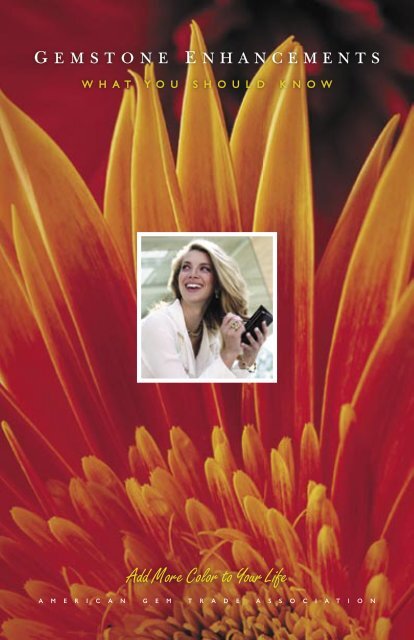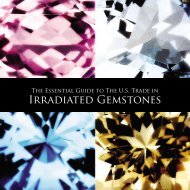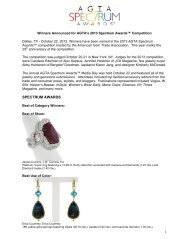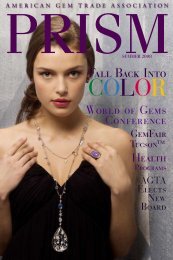Gemstone Enhancements "What You Should Know".
Gemstone Enhancements "What You Should Know".
Gemstone Enhancements "What You Should Know".
- No tags were found...
Create successful ePaper yourself
Turn your PDF publications into a flip-book with our unique Google optimized e-Paper software.
A fine cut gemstone offers the fulla r r ay of nat u r e’s intricatebeauty, highlighted by the skillof the l a p i da r y ’s a r t.
G E M S T O N E S. . . . . . . . . . . . . . . . . . . . . . . . . . . . . . . . . . . . . . . . . . . . .Acrystal fragment from deep within theearth, a raw natural creation…. No othertreasure of the earth has inspired man’sdesire to capture and possess its extraordinarybeauty like a gemstone. The spell a gem casts overthe imagination is so powerful, it has also inspiredus to free its beauty from imperfection and to moldits shapes and colors for adornment and to expressour individuality.For thousands of years, man has fashioned uncut gem specimensinto faceted and cabochon shapes. By experimenting with cuttingtechniques that enhance the play of light across their surfaces,we have coaxed brilliance and fire from deep within. A fine cutgemstone offers the full array of nature’s intricate beauty,highlighted by the skill of the lapidary’s art. Pearls, formed bycrystals of organic origin, are complete in form as they areharvested from sea and river animals. Luminous, these pearlsevoke awe and wonder.In addition to gemstone cutting, over the centuries we havedeveloped countless other methods to improve upon the naturalproperties of gemstones and pearls. These techniques areknown as enhancements. They derive from our desire to drawfrom nature’s bounty the truest and purest color and brilliance.A basic understanding of these enhancement techniques willadd to your appreciation of the beauty, durability, and value ofgemstone jewelry.A M E R I C A N G E M T R A D E A S S O C I A T I O N
Great thinkers like Leonardo da Vincibelieved that amethyst could dissipate evilthoughts and quicken the intelligence.A m e t h y s t / C i t r i n e. . . . . . . . . . . . . . . . . . . . . . . . . . . . . . . . . . . . . . . . . . .Amethyst and citrine are gemstone varieties of quartz. Purplehas long been considered a royal color, so it is not surprisingthat amethyst has been so much in demand throughout history. Fineamethysts are featured in the British Crown Jewels and were also afavorite of Catherine the Great and Egyptian royalty. Great thinkerslike Leonardo da Vinci believed that amethyst could dissipate evilthoughts and quicken the intelligence.Named from the French word for lemon, citron, many citrineshave a juicy lemon color. Sunny and affordable, citrine can brightenalmost any jewelry style, blending especially well with the yellowgleam of polished gold. In ancient times, citrine was carried as aprotection against snake venom and evil thoughts.Darker hues of amethyst are rarely enhanced to perfect their color,although some varieties do respond well to heat enhancement.Brownish varieties are commonly heated and magically turn into thebright yellow or orange colors known as citrine. This enhancementmethod is permanent and will last for the life of the gemstones.A M E R I C A N G E M T R A D E A S S O C I A T I O N
A q u a m a r i n e. . . . . . . . . . . . . . . . . . . . . . . . . . . . . . . . . . . . . . . . . . .The very name aquamarine brings to mind the limpid, clear bluetint of the sea. Legend says that it is the treasure of mermaids,with the power to keep sailors safe at sea. Aquamarine was longthought to have a soothing influence on married couples, makingit a good anniversary gift.Many aquamarines are greenish when mined and cut. For thosewho prefer a purer blue, these stones are heated to enhance theirblue color permanently. Some aquamarine fanciers prefer thegreenish hues, saying the greener tones remind them more of thesea. The color tones of aquamarine are subtle and varied. Theirsoft luster is a wonderful addition to any natural colored gemstonejewelry collection.L e g e n d s a y s aqua m a r i n e i s t h etreasure of mermaids, with thepower to keep sailors safe at sea.
According to ancient Chinese legend,the moon holds the power to createpearls, instilling them with its celestialglow and mystery.
C u l t u r e d P e a r l s. . . . . . . . . . . . . . . . . . . . . . . . . . . . . . . . . . . . . . . . . . .According to ancient Chinese legend, the moon holds thepower to create pearls, instilling them with its celestialglow and mystery. Pearls have been treasured for their lustrous,creamy texture and subtle iridescent reflections since the dawnof humankind.Because natural pearls are so rare and difficult to recover fromthe ocean’s depths, man invented the technique of culturingsalt and freshwater pearls from mollusks carefully seeded withirritants similar to those produced by nature. The painstakingeffort of culturing is one of the most dramatic examples of man’squest to coax beauty from nature.Due to demand for perfectly matched white pearl strands, culturedfresh and saltwater pearls are often bleached to achieve a uniformcolor. They may also be polished in tumblers to clean and improvetheir luster.Pearls are most commonly thought of as white, but they are actuallyproduced in many colors, including gold, yellow, champagne, pink,peach, lavender, gray, and black.Dyes, heat treatment, and irradiation are sometimes applied toproduce a wide range of hues such as yellow, green, blue, purple,gray, and black in freshwater and Akoya cultured pearls. SomeSouth Sea cultured pearls are bleached to lighten their hue, butmost South Sea and Tahitian cultured pearls are not subjectedto enhancements to create or improve their color.Produced by a living organism, pearls require special care becausethey contain calcareous crystals that are sensitive to chemicalsand acids. To care for your cultured pearls, avoid using perfume,hairspray, abrasives, solvents, and nail polish removers whilewearing them. Like your skin, cultured pearls contain water andmay dehydrate and crack if exposed continuously to arid conditions.<strong>You</strong>r jeweler will tell you how to best care for your cultured pearls.A M E R I C A N G E M T R A D E A S S O C I A T I O N
An organic gem from the sea, coral wasbelieved to bestow wisdom, protectfrom evil, heal wounds, and calm the soul.C o r a l. . . . . . . . . . . . . . . . . . . . . . . . . . . . . . . . . . . . . . . . . . .Coral is among the most ancient of gem materials, used foradornment since prehistoric times. Coral inlays and ornamentshave been found in Celtic tombs from the Iron Age.An organic gem from the sea, coral was believed to bestow wisdom,protect from evil, heal wounds, and calm the soul. A semi-translucentto opaque gem, coral is formed from a colony of marine invertebratesand primarily made of calcium carbonate.White is the most common color in coral, but a variety of other shadescan be found, including pink, orange, red, and black. The rarest coloris a deep red.Coral is commonly enhanced to improve its color and durability. Whitecoral is bleached. Pink coral is permeated with a colorless wax andorange coral is stabilized with plastic. Black coral is sometimes bleachedto create gold coral. Occasionally, red coral is dyed to deepen or uniformits color. All commonly used forms of coral enhancement are stable.Special care is required for coral regardless of whether or not it is enhanced.A soft and porous gem, coral scratches and abrades easily and chlorine,alcohol, ammonia, nail polish remover, and other chemicals can damageit. Remove coral rings when washing and moisturizing your hands.Avoid exposing your coral to extreme temperatures. <strong>You</strong>r jeweler will tellyou how to best care for coral.A M E R I C A N G E M T R A D E A S S O C I A T I O N
D i a m o n d. . . . . . . . . . . . . . . . . . . . . . . . . . . . . . . . . . . . . . . . . . .Unique in the world of gemstones, diamond is thehardest of all substances. Perhaps it isbecause of this durability that diamond is treasuredas a symbol of lasting devotion.Diamond is celebrated for the purity of its brilliance. Yet within thestructure of diamond, we often find impurities, or inclusions,that deflect light, distracting our eye from the radiance we so value.Many of these tiny imperfections are removed when the diamond isshaped. Today, cutters also have the option of using an enhancementtechnique that focuses tiny beams of laser light at imperfectionsand vaporizes them. The minute passageways created by the lasermay then be filled with clear resins or glass-hard substances,rendering them nearly invisible to the naked eye. This method canalso be used to fill fissures that reach the stone’s surface, renderingthem less visible to the naked eye. This treatment is permanent: onlyextreme heat or specifically formulated chemicals will remove thefilling from the laser passageways or fissures.Diamonds may also be colored in a variety of hues. Extreme heatand irradiation permanently enhance certain innate color properties,allowing them to display their hues in more brilliant array.Black diamonds, for example, are usually enhanced in this way.A new high-pressure high-temperature treatment, known asHPHT, can improve the color of certain types of diamonds. HPHTtreatment can remove tints from some diamonds, making themmore colorless, or intensify the pink, blue, green, and yellow colorsin others. Because HPHT diamonds sell for less than naturallycolored diamonds, industry rules require HPHT-treated stones tobe identified with an inscription on the girdle of the diamondto prevent misrepresentation.Whether color enhanced, lasered, or cut from the most perfect rawstate, your jeweler will inform you of the magical journey yourdiamond has followed, from deep within the earth’s mantle to thefine, finished gemstone you see before you.A M E R I C A N G E M T R A D E A S S O C I A T I O N
R u b y. . . . . . . . . . . . . . . . . . . . . . . . . . . . . . . . . . . . . . . . . . .Gem of passion, of smoldering desire, ruby has been treasuredfor thousands of years. Because the ancients thought itsglowing red color was due to an inextinguishable inner fire, rubywas also always associated with courage and power.Throughout most of recorded history, ruby has been the mostvaluable of gems. It was believed wearing a fine red ruby bestowedgood fortune on its owner — although the owner must havealready had good fortune enough to possess such a rare andbeautiful gem!Despite all the best efforts of gem merchants to use technologyto enrich color, fine ruby is still exceptionally rare. After beingextracted from the earth, rubies today are commonly heated tohigh temperatures to maximize the purity and intensity of theirred hue. Impurities may also dissolve or become less noticeableafter heating. However, heating will only improve the color ifthe gem already contains the chemistry required. Occasionallyrubies with small imperfections are permeated with a silicatebyproduct of the heating process, which helps to make smallfissures less visible. This enhancement, like heating, is permanentand rubies, whether enhanced or not, remain among the mostdurable of gems.Today a new method of artificially coloring the surface of palerrubies or dark purple sapphires through the diffusion of beryllium,or a similar element, has made the red of ruby more affordable.Although this method is not yet common, in the future berylliumdiffusedrubies may offer an affordable alternative to eitheruntreated or heat-enhanced rubies, which are both much morerare. However, recutting or repolishing may affect the color ofsome beryllium-diffusion treated stones.A M E R I C A N G E M T R A D E A S S O C I A T I O N
Gem of passion, of smolderingdesire, ruby has beentreasured for thousands of years.
E m e r a l d. . . . . . . . . . . . . . . . . . . . . . . . . . . . . . . . . . . . . . . . . . .Emerald, to many, symbolizes rebirth and the abundance of thelife force. The rich green hue brings to mind the regenerationof life in spring and hope of new possibilities.Spring can also be seen in the network of inclusions in the depthof the emerald that the French call the jardin, or garden, becauseit resembles foliage. The inclusions are like a fingerprint, givingeach emerald a distinct personality and distinguishing them as trulynatural gemstones.Early gem merchants sought to purify the transparency of theiremeralds by immersing them in clear oils or paraffin. They foundthat clear oils and waxes rendered surface fissures less visible tothe eye. Today, we have many sophisticated technologies with whichto clarity-enhance emeralds. In addition to the oils and waxes ofancient methods, we now use clear resins to penetrate the openfissures surfacing in the stones. Hardeners are often added tosolidify these liquids. This step prevents the resin from evaporating,thus making the clarity enhancement more permanent than oilingor waxing the gem.Although emerald itself is quite durable, the garden ofinclusions may make individual gems vulnerable to damageif handled roughly. Ask your jeweler for informationregarding your emerald selection and care. Tounderstand the journey your emerald has traveled fromthe earth to you is to gain special insight into its magic.The ancients believed emeraldsempowered their ownerwith foresight into the future.
O p a l. . . . . . . . . . . . . . . . . . . . . . . . . . . . . . . . . . . . . . . . . . .Revered as a symbol of hope, fidelity, and purity, opal wasdubbed the Queen of Gems by the ancient Romans becauseit encompassed the colors of all other gems. Opal is prized forits unique play of color, the ability to diffract light into flashes ofrainbow color.Opal occurs in different colors, ranging from semi-transparent toopaque. The most common is white opal. Crystal or water opal has acolorless body. The most valued variety, black opal, has a dark blue,gray, or black body color. Boulder opal combines precious opalwith the ironstone in which it forms. Bright yellow, orange,or red fire opal are quite different from the other varieties ofopal. Their day-glo tones, which are translucent to transparent,are beautiful with or without play of color.Although opal is rarely enhanced by methods other than cuttingand polishing, opals can be treated to bring out their play of color.One technique is to immerse white, gray, or black opal in a sugarsolution and then in strong sulfuric acid, which carbonizes with thesugar and leaves microscopic carbon specks that blacken thebody color, making its flashes of color more visible. Opals can alsobe permeated with colorless oil, wax, resin, plastic, and hardenersto improve their appearance and durability. Occasionally, somethinner or translucent opal may be painted with a black epoxyon the backside of the gemstone to darken the body color andimprove the play of color. Fire opal is not commonly enhanced.Opal, with or without enhancement, should be treated with somecare. Opal is softer than many other gems and should be storedcarefully to avoid being scratched by other jewelry. It should also beprotected from blows, as exposed corners can chip. Opal shouldnot be exposed to heat or acid.A M E R I C A N G E M T R A D E A S S O C I A T I O N
In ancient times, a gift of a sapphire was apledge of trust and loyalty. It is from thistradition that sapphire has long been a popularchoice for engagement rings.
S a p p h i r e. . . . . . . . . . . . . . . . . . . . . . . . . . . . . . . . . . . . . . . . . . .Velvety blue. Liquid blue. Evening-sky blue. Cornflower blue.Because sapphire embodies an infinite palette of blue hues,ancients believed that the earth rested on a giant sapphire and itsreflection colored the sky.But like the endless colors that appear in the sky, sapphire is alsofound in many, many other shades besides blue, from the gold of asunrise, to the fiery reddish-orange of sunset, to the delicate violet oftwilight. Sapphire may even resemble the pale white gloaming of anovercast day.In ancient times, a gift of a sapphire was a pledge of trust and loyalty.It is from this tradition that sapphire has long been a popular choicefor engagement rings.Yet the perfect sapphire is as rare as the finest work of art. Thus, overthe centuries, we have developed methods to enhance the puresthues of sapphire. This is now commonly achieved by controlledheating of these gems, a technique that not only improves colorbut also improves clarity. But heating will only improve the color if thegem already contains the chemistry required. Heating sapphires isa permanent enhancement, as lasting as the gemstones themselves.A new method of artificially changing the natural color of a sapphireis diffusion, whereby beryllium or a similar element is diffused intothe surface of the gem, producing a richer color. Sapphire treatedby diffusion is far less costly and much more available than rarefine untreated gems or those successfully heat-treated. Diffusedsapphire is available in shades of orange, pinkish orange, yellow,and sometimes even blue. Information about diffusion should beprovided on the invoice for your jewelry. Recutting or repolishingmay affect the color of some diffusion-treated stones. <strong>You</strong>r jewelercan help you decide whether a natural, heated, or diffused sapphireis right for you.A M E R I C A N G E M T R A D E A S S O C I A T I O N
Ta n z a n i t e. . . . . . . . . . . . . . . . . . . . . . . . . . . . . . . . . . . . . . . . . . .Tanzanite, the ultimate prize of a gem safari, has a mesmerizingblend of rich purples and blues with a velvety deepness ofcolor unlike any other gem. Mined only in Tanzania at the feetof the majestic Mount Kilimanjaro, virtually every tanzanite isheated to permanently change its color from orange-brown tothe spectacular violet-blue color for which this preciousgemstone variety is known.Legend has it that the effect of heat was first discovered when somebrown gem crystals lying on the dry earth were caught in a fire setby lightning that swept through the grass-covered hills. The Masaiherders driving cattle in the area noticed the beautiful blue colorand picked the crystals up, becoming the first tanzanite collectors.Legend has it that the effect of heat wasfirst discovered when some brown gem crystalslying on the dry earth were caught in af i r e set by lightning that swept through thegrass-covered hills.
To p a z. . . . . . . . . . . . . . . . . . . . . . . . . . . . . . . . . . . . . . . . . . .T he Egyptians said that topaz was colored with the goldenglow of the sun god. Legend has it that topaz dispelsall enchantment and helps to improve eyesight. The ancientGreeks believed that it had the power to increase strengthand make its wearer invisible in times of emergency.Topaz sometimes has the amber gold of fine cognac or theblush of a peach, and all the beautiful warm browns andoranges in between. Some rare and exceptional examplesare pale pink to a sherry red. Sometimes peach-coloredtopaz can be “pinked” by gentle heating. This colorchange is permanent.Blue, once the most rare color of topaz, is today the mostcommon, thanks to a stable enhancement process that turnscolorless topaz blue. After the raw topaz is extracted fromthe earth and cut, it is irradiated to brown and then heated tosky blue. This enhancement process is permanent.Due to the popularity of blue topaz, a new treatment processcalled vapor deposition has been developed to create additionalcolors of topaz. In this treatment process, similar to those usedby opticians and camera makers to make lens coatings, a thincolored film is bonded on the surface of topaz to create darkblue, red, pink, and green colors or rainbow iridescence.These vapor deposition-enhanced topaz colors must be handledwith special care, as the coating can be scratched or abraded.Topaz is a very hard gemstone, with a Mohs hardness of 8, butit can be split with a single sharp blow, a trait it shares withdiamond. As a result it should be protected from hard knocks.Clean with mild dish soap; use a toothbrush to scrub behindthe stone where dust can collect.A M E R I C A N G E M T R A D E A S S O C I A T I O N
A nci e n t m yst ic s be l i ev e dtou r m a l i n e coul dencour age artistic intuition:it h a s th e pa l et t eto expr e s s e v e ry mo od.To u r m a l i n e. . . . . . . . . . . . . . . . . . . . . . . . . . . . . . . . . . . . . . . . . . .Tourmaline’s name comes from the Sinhalese word turmali,which means “mixed.” Occurring in more colors orcombinations of colors than any other gemstone variety found innature, this gem lives up to its name. Perhaps this is why ancientmystics believed tourmaline could encourage artistic intuition: ithas the palette to express every mood.Dark blue, blue-green, and green tourmalines are occasionallyheated to lighten their color. Red tourmalines, also known asrubellites, and pink varieties are sometimes heated or irradiatedto improve their colors. Heat and irradiation color enhancementof tourmalines is permanent.Occasionally, some tourmalines may have surface-breaking fissuresthat are filled with resins, with or without hardeners. Care must beobserved with these gems. Avoid exposing them to harsh abrasivesand strong chemical solvents.A M E R I C A N G E M T R A D E A S S O C I A T I O N
Tu r q u o i s e. . . . . . . . . . . . . . . . . . . . . . . . . . . . . . . . . . . . . . . . . . .While turquoise is usually associated today with Native Americanculture, the ancient Egyptians were mining turquoise in3,200 BC. Many ancient cultures regarded turquoise as a source ofmetaphysical power. Turquoise was thought to protect from evil,maintain virtue, and bring good luck.Turquoise is an opaque, light to dark blue or blue-green gem. Thefinest color is an intense blue. Turquoise may contain narrow veinsof other materials either isolated or as a network. They are usuallyblack, brown, or yellowish-brown in color. Known as the matrix,these veins of color are sometimes in the form of an intricate pattern,called a spider web.To improve its color and durability, turquoise is commonly permeatedwith plastic, a stable enhancement. It is also sometimes permeatedwith colorless oil or wax, which is considered not as stable as plastic.Some turquoise is dyed to improve its color, but rarely, as this is anunstable enhancement.Special care is required for turquoise regardless of whether or notit is enhanced. A porous gem, turquoise can absorb anything ittouches. Avoid contact with cosmetics, perfumes, skin oil, acids,and other chemicals. Avoid dehydrating it or exposing it to heat.<strong>You</strong>r jeweler will tell you how to best care for your natural gemstone.Turquoise was thought toprotect from evil, maintain virtue,and bring good luck.A M E R I C A N G E M T R A D E A S S O C I A T I O N
T h i s b r i e f d e s c r i p t i o no f g e m e n h a n c e m e n t s d o e s n o tc o v e r a l l g e m s t o n e sthat are treated today. For moreinformation please contactthe American Gem Trade Associationat 214.742.4367.Add More Color to <strong>You</strong>r Life3030 LBJ FREEWAY, SUITE 840, DALLAS, TEXAS 75234214-742-4367 FAX 214-742-7334 w w w. a d d m o r e c o l o r t o y o u r l i f e . c o mA M E R I C A N G E M T R A D E A S S O C I A T I O N
















